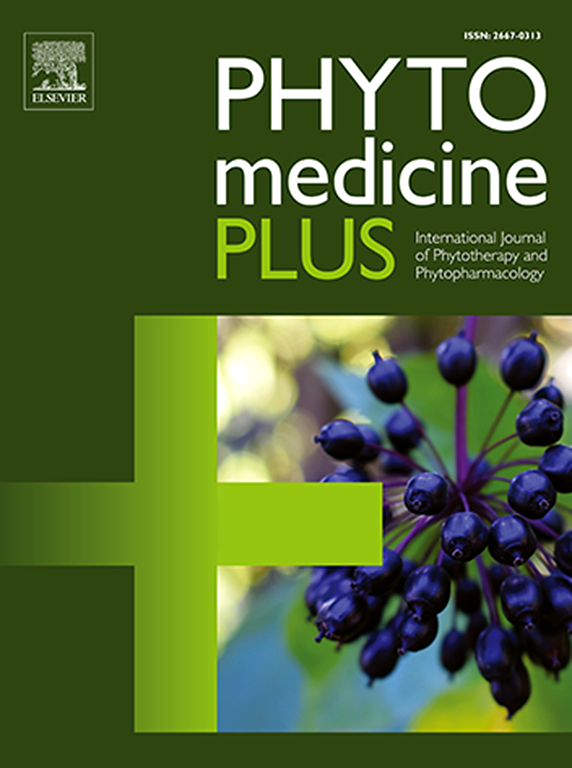最大化SCOBY生长的生物工艺策略,以及评价玫瑰茄康普茶发酵动态对酚含量和抗氧化活性的影响
Q3 Pharmacology, Toxicology and Pharmaceutics
引用次数: 0
摘要
以玫瑰为基础的康普茶是一种很有前途的功能性饮料,因为它含有生物活性化合物、高酚含量和花青素,有助于颜色稳定、抗炎和保护心脏。本研究旨在优化发酵参数——玫瑰叶浓度、蔗糖水平和细菌与酵母的初始共生培养(SCOBY)质量——以提高微生物活性、酚稳定性和抗氧化性能。高效液相色谱(HPLC)鉴定出绿原酸(270.62 mg L -⁻¹)、槲皮素-3-葡萄糖苷(31.96 mg L -⁻¹)和芦丁(7.7 mg L -⁻¹)是主要的酚类物质,原儿茶酸在14天内增加。优化后的发酵条件(5 g rosselle, 12%蔗糖,25 g SCOBY)与传统的康普茶相比,SCOBY生长(41.66 g)更高,生物活性稳定性更好。发酵对关键参数的影响显著:由于有机酸的缓冲作用,pH保持稳定(2.16 ~ 2.21),可滴定酸度增加(0.60% ~ 2.33%),蔗糖浓度降低(12.0 ~ 10.2°白利度)。颜色分析(CIELab)揭示了色素的动态变化,反映了花青素的降解和转化。储存稳定性测试表明,酚类化合物在4℃下保持稳定,而室温储存增加了酚类化合物的含量,可能是由于持续的微生物代谢。抗氧化活性测定证实了强大的抗氧化潜力,IC50值在冷藏中保持稳定:DPPH(9.71至9.59 mg L -⁻¹),ABTS(8.68至7.60 mg L -⁻¹)和FRAP(10.01至9.84 mg L -⁻¹)。这些发现强调了康普茶作为一种可扩展的、营养增强的功能性饮料的潜力,强调了其在优化的发酵和储存条件下的酚稳定性和抗氧化性能。本研究为规模化生产、提高成本效益、推进功能性饮料的开发提供了实用的见解。本文章由计算机程序翻译,如有差异,请以英文原文为准。
Bioprocess strategies for maximizing SCOBY growth and evaluating fermentation dynamics on phenolic content and antioxidant activity in Roselle-based Kombucha
Roselle-based kombucha is a promising functional beverage due to its bioactive compounds, high phenolic content, and anthocyanins, which contribute to color stability, anti-inflammatory effects, and cardioprotective benefits. This study aimed to optimize fermentation parameters—roselle concentration, sucrose levels, and initial symbiotic culture of bacteria and yeast (SCOBY) mass—to enhance microbial activity, phenolic stability, and antioxidant properties.
High-performance liquid chromatography (HPLC) identified chlorogenic acid (270.62 mg L⁻¹), quercetin-3-glucoside (31.96 mg L⁻¹), and rutin (7.7 mg L⁻¹) as predominant phenolics, with protocatechuic acid increasing over 14 days. Optimized fermentation conditions (5 g roselle, 12% sucrose, 25 g SCOBY) resulted in higher SCOBY growth (41.66 g) and superior bioactive stability compared to traditional tea kombucha. Fermentation significantly influenced key parameters: pH remained stable (2.16 to 2.21) due to buffering organic acids, titratable acidity increased (0.60% to 2.33%), and sucrose concentration decreased (12.0 to 10.2 °Brix). Color analysis (CIELab) revealed dynamic pigment changes, reflecting anthocyanin degradation and transformation. Storage stability tests showed that phenolic compounds remained stable at 4°C, while room-temperature storage increased phenolic content, likely due to continued microbial metabolism. Antioxidant activity assays confirmed robust antioxidant potential, with IC50 values remaining stable in cold storage: DPPH (9.71 to 9.59 mg L⁻¹), ABTS (8.68 to 7.60 mg L⁻¹), and FRAP (10.01 to 9.84 mg L⁻¹). These findings underscore roselle kombucha's potential as a scalable, nutritionally enhanced functional beverage, emphasizing its phenolic stability and antioxidant properties under optimized fermentation and storage conditions. This study provides practical insights for scaling production, improving cost-efficiency, and advancing functional beverage development.
求助全文
通过发布文献求助,成功后即可免费获取论文全文。
去求助
来源期刊

Phytomedicine Plus
Medicine-Complementary and Alternative Medicine
CiteScore
3.70
自引率
0.00%
发文量
178
审稿时长
81 days
期刊介绍:
 求助内容:
求助内容: 应助结果提醒方式:
应助结果提醒方式:


